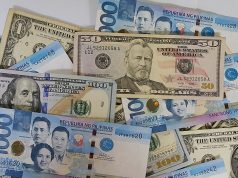Peso to weaken on Fed, new variants

THE PESO is expected to retreat further versus the greenback in 2022 as investors opt for safe havens amid the more hawkish stance of the US Federal Reserve, and with new variants of the coronavirus disease 2019 (COVID-19) clouding recovery prospects.
The local unit closed at P50.999 per dollar on Dec. 31, the final trading day for 2021, shedding P2.976 or 6.2% from its P48.023 finish on Dec. 29, 2020.
A trader in an e-mail said the peso closed weaker last year as the Fed became more hawkish amid lingering risks caused by elevated US inflation.
“We see the dollar to continue its strength as the US Fed pushes through with its hawkish stance and start raising rates sooner rather than later,” UnionBank of the Philippines, Inc. Chief Economist Ruben Carlo O. Asuncion said in an e-mail.
In November, US Fed Chairman Jerome H. Powell said inflation could no longer be accurately described as transitory. Fed officials have also agreed to quicken the pace of their taper timetable for purchase of assets and have said they expect up to three rate hikes this year.
Mr. Asuncion said there would also likely be a flight towards safe-haven currencies as an initial reaction to COVID-19 variants and the infection surge, which could cause the peso to weaken.
Data from the Centers for Disease and Control Prevention showed that about 58.6% of COVID-19 patients in the US are sick with the more transmissible Omicron variant, Reuters reported.
Other countries in Europe and Asia as well as Australia have also seen an uptick of cases in the previous weeks.
At home, Metro Manila will be placed under the stricter Alert Level 3 from Jan. 3 to 15 amid the rising infections. On New Year’s Day, active cases rose 3,617 while the infection rate hit 14.8%, which is beyond the 5% threshold set by the World Health Organization.
Rizal Commercial Banking Corp. Chief Economist Michael L. Ricafort said the market will also be monitoring the country’s vaccination progress.
More than 49.7 million have been fully vaccinated in the country as of Dec. 31, based on data from the Department of Health. This is below the 54-million target of the government by the end of 2021.
The fully vaccinated make up 49.9% of the country’s population, according to data from the Johns Hopkins University.
Developments related to disruptions and improvements on the global supply chain could also affect the peso’s movement this year, Mr. Ricafort added.
Meanwhile, Mitsubishi UFJ Group Global Research analyst Sophia Ng said a larger trade deficit caused by likely higher oil import bill could also cause the peso to depreciate.
For this year, Mr. Asuncion gave a forecast range of P51 to P53, while Mr. Ricafort expects the local unit to trade within P51 to P52 versus the greenback. Ms. Ng’s outlook for the peso is an end-2022 close of P51.50 per dollar. — Luz Wendy T. Noble with Reuters



